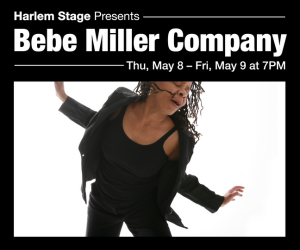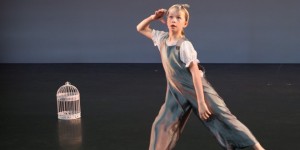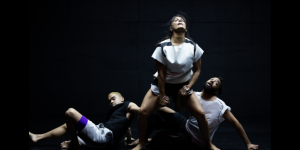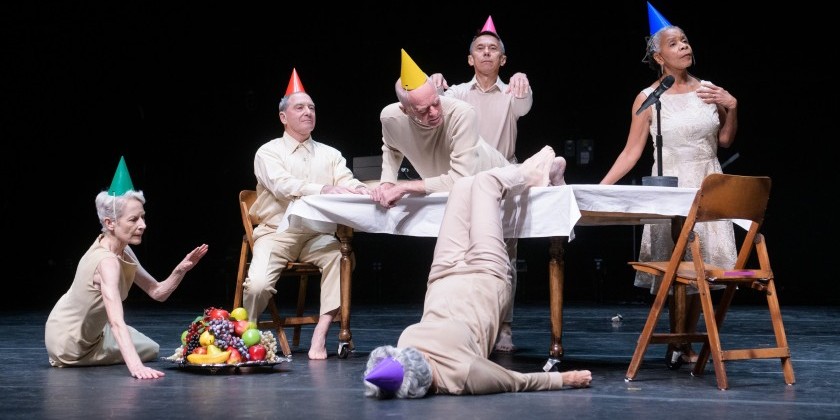IMPRESSIONS: Netta Yerushalmy's "Paramodernities" at New York Live Arts

March 14, 2019
Creation: Netta Yerushalmy
With significant contributions from the dancers and scholars: Michael Blake, Gerald Casel, Marc Crousillat, Thomas F. DeFrantz, Joyce Edwards, Brittany Engel-Adams, Julia Foulkes, Stanley Gambucci, Taryn Griggs, Magdalena Jarkowiec, Georgina Kleege, David Kishik, Nicholas Leichter, Mara, Mills, Claudia La Rocco, Jeremy Jae Neal, Carol Ockman, Hsiao-Jou Tang, and Megan Williams
Guest performer/speaker on March 14: Bill T. Jones
Uninhibited by convention, Netta Yerushalmy, in her epic work Paramodernities (presented in March by New York Live Arts), partners movement signatures from select works spanning the 20th-century Western dance canon with the recited writings of critical theorists to examine the topic of the body.
The danced movement is less primary to this work than it is a component within an impressive analysis of the politics of the body.
Sex, race, health, ability, power, ownership, trauma, and disentitlement are but some of the multitude of topics offered for consideration in this engrossing and thought-provoking nearly four-hour event.

Yerushalmy performs in this work alongside a generationally, culturally, and physically diverse roster of dancers from across the field. Erudite authors take their place onstage with the dancers, becoming physically integrated into the scenes as they speak their text. Their relationship to the dancers supports each section’s premise (or multiple premises).
Yerushalmy’s dancing is sturdy, but it is her curatorial skills and formidable intellectual curiosity that impress. Just one track of this rich inquiry could sustain a performative dissertation. But Yerushalmy paves a mille-feuille-ed response, webbing together numerous notions of the body at once.
The indefatigable, linear, and technically appealing Marc Crousillat paces through a deconstructed collage of Cunningham steps with his dynamic and skillful partner Brittany Engel-Adams . We encounter the past in the present -- appropriation, stripped-away artifice, struggle. mortality, and prowess -- all this together with Claudia La Rocco’s emceeing, offers a reinforcement of Cunningham’s ethos and process, embracing the arbitrary.

In each of the six sections of Paramodernities — responses to Nijinsky’s Le Sacre du Printemps, Martha Graham’s Night Journey, Bob Fosse’s Sweet Charity, multiple works by Cunningham, George Balanchine’s Agon, and Alvin Ailey’s Revelations— the ethics of representation are questioned and challenged.
The section responding to Graham both recycles select steps from Night Journey and displays footage from a 1960 video by Alexander Hammid of the iconic work .How do Graham’s movements resonate with us now, more than 70 years later, out of context, and articulated through non-Graham-like bodies?
The most captivating movement is not the decontextualized embodiment of steps danced by Taryn Griggs and Yerushalmy, but the two dancers’ smothering, groping, interrupting, and imposing upon writer and speaker Carol Ockman. The relationship and interaction between bodies offers palpable tension and disturbance that speaks to a history of power imbalance and abuse, but also—through Ockman’s cool response and unflappability—the resilience of humankind.
Presenting Graham’s movements in this setting echoes the idea of female strength in the reminder of this pioneering woman who changed the language and narrative of Western concert dance.
.jpg)
Through simple yet effective alterations to the space, Yerushalmy succeeds in providing reinvigoration for spectators over the lengthy duration of this work. The audience is periodically invited to sit on the perimeter of the stage, providing a new perspective, physical stimulation through the action of relocation, and an existential metaphor for our participation and accountability in life.
Yerushalmy presents bits of Ailey’s material with Thomas F. DeFrantz’s impassioned recitation in a barrier-breaking spatial format to recall the past, announce the present, and suggest a potential future. The fourth wall is again shattered as dancers in the final section bound onto the auditorium seats and strike poses from Alvin Ailey’s “’Buked” section of Revelations. A move with outstretched arms and an upward gaze in the context of Ailey’s work might portray an oppressed people holding up the weight of the world; here, placed on top of the raked seating, it seems to take on a new meaning, perhaps reflecting political shifts over time or a hope for the future, as the body looms larger than life, claiming rights and taking flight.

This work’s many considerations of the body provokes contemplation of our own humanity. As a body physicalizing one choreographer’s language bleeds into a scene with movement from another, the inevitability of influence, relationship, repercussion, and inspiration is hinted at. We are further reminded of lineage and our role within life’s continuum.
The Dance Enthusiast Shares IMPRESSIONS/our brand of review and Creates Conversation.
For more IMPRESSIONS, click here.
Share your #AudienceReview of performances. Write one today! Read more about Netta Yerushalmy on The Dance Enthusiast:
Netta Yerushalmy Cubed, Helga and The Tree Sailors, Preparing for Devouring Devouring














